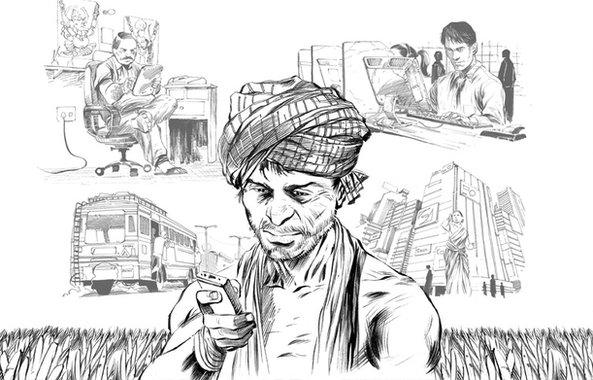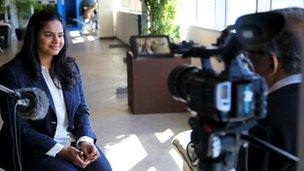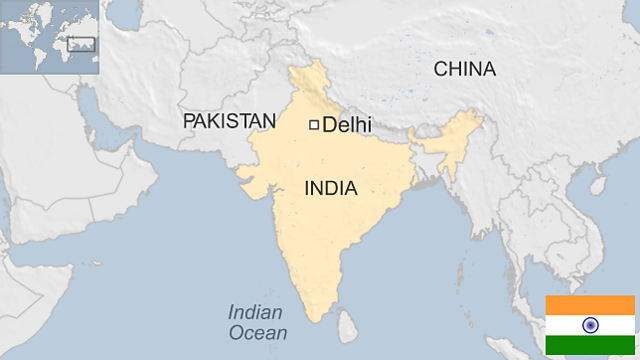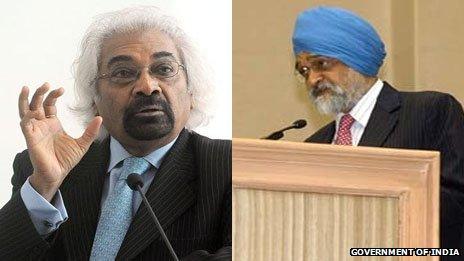Digital Indians: Five pioneers of technological innovation
- Published

Analysts believe there are 75 million internet users in India (Illustration: Sumit Kumar)
What does a wealthy entrepreneur who's creating the digital ID of a billion people have in common with someone making videos in farms?
And what does a young woman who created key features at the world's top social-networking company have in common with a man who's helping three million people find jobs - or with someone who's busy refining 100 billion searches every month?
They all have roots in India - and they're pioneering digital innovation in India and across the world.
Risk takers
Take the young man in Delhi who left a multinational job and struggled for nearly a decade, often without a salary. The little job site that Sanjeev Bikhchandani set up in 1997 is now India's top web business - and all because he saw colleagues reading business magazines backward, starting with the job adverts.
There were fewer than 15,000 internet users in India then.
Today, there are 165 million, according to India's telecom regulator. Internet analytics company comScore says that India is now at a tipping point for an online business. Setting up one 16 years ago was a big leap of faith.
This is also the story of a 23-year-old from Pune who joined a start-up that looked like it was a dating service for college kids, as its first female engineer. Ruchi Sanghvi became principal product manager at Facebook, in charge of key features such as news feed.
And then, at 29, this rising star quit her job to launch a start-up. She and her co-founders were acquired a year later by Dropbox, a cloud-storage company in Silicon Valley.
It's the story of Ben Gomes from Bangalore, who once tinkered around on a little British ZX Spectrum computer at home, and then later went on to refine and drive the search experience for one of the world's top web-search company.

Ruchi Sanghvi was one of Facebook's first employees - and the first female engineer
The next time you see the auto-suggestions Google gives you as you begin typing a query, and the snippet of text and links you get back, you can thank this young man in Mountain View.
Or take the 26-year-old who co-founded a software start-up in Bangalore, and helped turn it into a global technology services giant. And then, 28 years later, Nandan Nilekani quit Infosys, to drive something he believed in: giving a digital identity to a billion Indians.
That little start-up, and others like it, pushed India's information technology and business process outsourcing (IT-BPO) industry across the $100bn mark in 2012. Nearly 70% of that was exports, according to industry association Nasscom, which says that India supplies nearly 60% of the IT-BPO services that are globally-sourced.
From space to farms
Then there's Rikin Gandhi, who gave up his dream of becoming an astronaut just as he came really close to it. He left the United States and came to India to work with farmers, using digital video to change what and how they learned. This is also his story.
Locally-produced video is a simple innovation for rural India, where internet penetration is low. Mobile use is ramping up, though.
For every 100 people in rural India, there are more than 40 mobile-phone subscriptions (compared with 139 in the cities). Of the 900 million telecom subscriptions in India, 97% are mobile connections, according to Indian authorities.
The mobile brought disruptive change to an industry that's rather old. India's telecom sector is still governed by the Indian Telegraph Act of 1885. Landline phones grew from zero to 30 million in a century. Mobiles have grown from zero to 870 million in 18 years.
India's infotech industry isn't as old as telecom, but it still clocks in at over three decades. The digital or web industry is much younger.
It all began when Mumbai-based Rajesh Jain started Indiaworld in 1995, for the non-resident Indian (NRI) community—India had no public Internet access then. Why a website? "I needed something to do after my image-processing software business failed," Mr Jain says.
Most people had never met this quiet, unassuming pioneer of web business in India, but they all recall the banner headline they saw four years later. And the 4,990,000,000 rupees (then £74m; $115m) for which Mr Jain sold his India world websites to Satyam Infoway.
That figure was an epiphany for those of us who thought we knew the web. And then America Online bought the world's largest media group, Time Warner, for $162bn (£104bn).
.jpg)
Take five: Nandan Nilekani, Ben Gomes, Rikin Gandhi, Ruchi Sanghvi and Sanjeev Bikhchandani
Many rose with the dotcom bubble; a few survived its crash in 2000. Those few came out hardier, with stronger digital businesses. This is their story too.
It's also the story of Indians who spread their wings across the tech world, to the hub of innovation, of the boom, the crash, and the recovery: Silicon Valley.
Take Ram Shriram from Chennai, who joined Netscape in the Valley before it had products, left to start Junglee.com, and sold it to Jeff Bezos for $185m of Amazon stock in 1998. He gave Google co-founders Sergey Brin and Larry Page their first big cheque, for $500,000, and regular advice in their Menlo Park garage. He's still on the board of Google, where four of the 13 leadership team members are of Indian origin.
The stories of Indians pioneering digital innovation are too many to tell in one place and time. They span the globe, and cross industries.
We've picked just five of those stories to tell from 2-27 September - Nandan Nilekani, Ben Gomes, Rikin Gandhi, Ruchi Sanghvi and Sanjeev Bikhchandani. Five people who are helping change the world, one megabyte at a time.
Meet the Digital Indians.
- Published3 September 2013

- Published2 September 2013
.jpg)
- Published10 March

- Published24 June 2013

- Published5 April 2013

- Published1 April 2013
